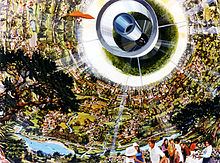Walden 3: Why Not Terraform Terra?
The movie poster for this discussion might go like this:
WALDEN III: the untaming!!
You loved the soulful David Thoreau in the all-time favorite Walden.
You were changed forever by director B.B. skinner’s sensitive portrayal of operant conditioning in Walden 2
Now prepare to be driven wild by Walden 3! The untaming!!!
But, it’s not a movie.
Walden 3 the story of an emerging way out of what some consider dire planetary circumstances. Is spaceship earth headed for a crash landing, with throttle is stuck on “full speed ahead”? The bad news: science works. The good news: humans and their cultures can fix the problems created by two hundred years of industrial civilization. Science, as the handmaiden of industry, was effective in creating the world we have today, including scary end-of-everything “externalities.” New computational tools reveal a complex world beyond scientific simplifications, making possible a culture that can better think and look ahead, and perhaps back off on the throttle and change direction.
Walden and Walden 2 were products of an age. They reflected the idea that progress meant to simplify, tame and control the world. Walden 3 suggests it may be time to view the world as necessarily complex. Restoraton, untaming and rewilding are words that have shown up to frame the use of new computational tools, such as computer simulation and big data, to blazing a trail toward a frontier of healthier human and natural communities. The new idea of progress is to use high tech tools to reign in the excesses of the Industrial Age and help local communities live lightly on the ground in a way that benefits all.
Movies sometimes deal with problems we can’t talk about. Daily living seems to rely on polite acceptance of conventional wisdom. That’s one way to frame physicist Stephen Hawking’s strange doomsday prediction in 2017. Driven wild he was not.
At this point, the movie, if it existed, would open with a brief apocalyptic scene in the year 2017 during which our hero is accidently flash frozen, only to wake up just in time for the premier, asking, “What is it, tame or untamed?” That would trigger the expected flashback to . . .
Stephen Hawking, the patron sage of science.
Hopeless Steve. In November 2016, the Sage gave mankind a thousand years to find a new planet to live on based on the usual suspects, climate change, comets, epidemics, overpopulations and robots.[i]. By May of 2017, he had reduced it to 100.[ii] The response of the Washington Post:
“Thanks, Steve.”[iii]
Hawking cherry suggestion conjured a vision of Earth as Titanic, with an iceberg dead ahead, the rudder jammed and a comet on its way. Time to leave.
A New Home. Since 2017 finds mankind reeling on the brink, Prof. Hawking’s final word is, find a new home.
The unstated question is whether Earthlings will just act like unmannerly aliens of director Roland Emmerich’s 1996 movie, Independence Day? In a bit of social critique, a traumatized Bill Pullman as President Whitmore says,
“I saw what they’re planning to do. They’re like locusts. They’re moving from planet to planet… their whole civilization. After they’ve consumed every natural resource they move on…”[iv]
Let us say some Planetary League for Ethical Development (PLED) sets standards. In order to live on a new world, Earthlings would have to responsibly terraform it and learn to live off the land. That means not importing a culture dedicated to extracting what is valuable, leaving a mess and moving on.
What are possible new homes? Earth’s Moon, near-Earth space, Mars and Venus are current favorites.[v] Fortunately for our pioneers, The Discovery Channel’s Flip my Planet has worked it out.[vi]

Mars could be terraformed in just a few thousand years.[vii]
Venus might take bit or two longer. In the meantime but living in a balloon city floating above its dense atmosphere would work fine (right.) [viii] [ix]

For the discerning Moon connoisseur, a developer would need to crash a lot of water-saturated comets, known as “iceteroids”, into it to provide an atmosphere, a bit of tilt and a faster rate of rotation around the Earth. The Moon could become a suitable second home spot in only decades. Add a bit of algae to produce oxygen and, according to Slate, it would be “a lot like Florida.” (above left) [x]

For the stay-at-home, an Omega America’s asteroid colonies (right) may be just the ticket.[xi]
For colonies in empty space, NASA says your getaway will be ready in about 50 years, but will be a bit pricey.[xii]
As Earth prepares to leave, our movie audience is invited to LOOK BACK ON ANOTHER STEVE, A HOPEFUL STEVE.
Hopeful Steve: January 23, 2000. A different Stephen Hawking sat with a reporter of the San Jose Mercury News for what became known as his Millennium Interview. In it, he proclaimed the hopeful news,
“I think the next [21st] century will be the century of complexity. We have already discovered the basic laws that govern matter and understand all the normal situations. We don’t know how the laws fit together, and what happens under extreme conditions. But I expect we will find a complete unified theory sometime this century. The is no limit to the complexity that we can build using those basic laws.”[xiii]
The Millennium Interview became “a widely cited prophesy” of the advent of a new set of complex tools to knock the world into shape.[xiv] [xv] [xvi]. Complex was the word used at the time to describe the promise of new tools, such a computer simulation, to better understand and so manage a future Earth. At the time, better weather forecasts and improved aircraft designs were saving lives. Computer models were mapping paths to healthy individuals, economies, forests and fisheries. What was not to like? The hopeful Stephen Hawking of January 23, 2000 was bullish on new tools for a new century.
The Restoration Economy. At about the same time, what became known as the restoration economy was just coming online partly based on use of the new tools. Above, SimCity is software that allows people to construct and then watch a virtual city in action. Forests, fisheries, economies and a myriad of other slices of human and natural life can be viewed this way. People interested in improvement could use simulations of almost anything, from forests to the human metabolism, to get a feel for how today’s efforts would play out in the future. Restoration didn’t just say “hands off.” Beginning in the 1980s, restoration promised I restore degraded landscapes by active human intervention. Computer modeling made that possible.
Restoration offers the promise of terraforming Terra – creating a livable planet. This seems like something positive to focus on for a generation schooled in hopelessness.
Follow a band of intrepid adventurers in Walden 3!! Coming to a theater near you in 2117.
Storm Cunningham’s 2002 The Restoration Economy proclaimed it “the greatest new growth frontier” flush with “immediate and emerging opportunities fir business, communities and investors.”[xvii] It was unstoppable.
So, what happened?
[i] Criss, Doug, “Stephen Hawking says we’ve got about 1,000 years to find a new place to live,” CNN, November 18, 2016, http://www.cnn.com/2016/11/17/health/hawking-humanity-trnd/index.html
[ii] Holley, Peter, “Stephen Hawking just moved up humanity’s deadline for escaping Earth,” Washington Post, May 5, 2017, https://www.washingtonpost.com/news/speaking-of-science/wp/2017/05/05/stephen-hawking-just-moved-up-humanitys-deadline-for-escaping-earth/?utm_term=.70cf9aa07bb5
[iii] Ibid
[iv] —, “Independence Day Quotes,” IMDb, http://www.imdb.com/title/tt0116629/quotes
[v] Warmflash, David, “Forget Mars. Here’s Where We Should Build Our First Off-World Colonies,” Discover, September 8, 2014, http://blogs.discovermagazine.com/crux/2014/09/08/where-build-off-world-colonies/#.WTA19xPyuF1
[vi] https://www.universetoday.com/121140/could-we-terraform-the-moon/
[vii] Contributor, “How long would it take to terraform Mars?” Quora, https://www.quora.com/How-long-would-it-take-to-terraform-Mars
[viii] Dvorsky, George, Should we terraform Venus first?” io9, October 11, 2012, http://io9.gizmodo.com/5950875/should-we-terraform-venus-first
[ix] Rundle, Michael, “5 Reasons Living In Venus Cloud Cities Would Be ‘Easier Than Colonising Mars’,” Huffington Post, November 24, 2014, http://www.huffingtonpost.co.uk/2014/11/24/venus-cloud-cities_n_6210584.html
[x] Benford, Gregory, “How to Terraform the Moon: It’ll be habitable, if a lot like Florida,”
[xi] Barry, Max, “Omega America’s Space Colonies,” Omega America II, https://www.nationstates.net/nation=omega_america_ii/detail=factbook/id=438206
[xii] —, “Space Settlement Basics,” https://settlement.arc.nasa.gov/Basics/wwwwh.html
[xiii] ‘”Unified Theory” Is Getting Closer, Hawking Predicts’, interview in San Jose Mercury News (23 Jan 2000), 29A. Answer quoted in Ashok Sengupta, Chaos, Nonlinearity, Complexity: The Dynamical Paradigm of Nature (2006), vii. Question included in Hans-Joachim Schellnhuber, Nicholas Stern and Mario Molina , Global Sustainability: a Nobel Cause (2010), 13. Cite from Brent Davis and Dennis J. Sumara, Complexity and Education: Inquiries Into Learning, Teaching, and Research (2006), 171.
[xiv] Gorban, A.N., and Yablonsky, G.S., “Grasping Complexity,” arXiv:1303v1 [cs:GL] March 15, 2013.
[xv] See Dahlen, Morten, The Century of Complexity,” Titan.uio.no Blog, February 2012, https://titan.uio.no/node/410
[xvi] Gorban, A.N., and Yablonsky, G.S., “Grasping Complexity,” arXiv:1303v1 [cs:GL] March 15, 2013.
[xvii] Cunningham, Storm, The Restoration Economy, Berrett-Koehler Publishers,
San Francisco, 2002.